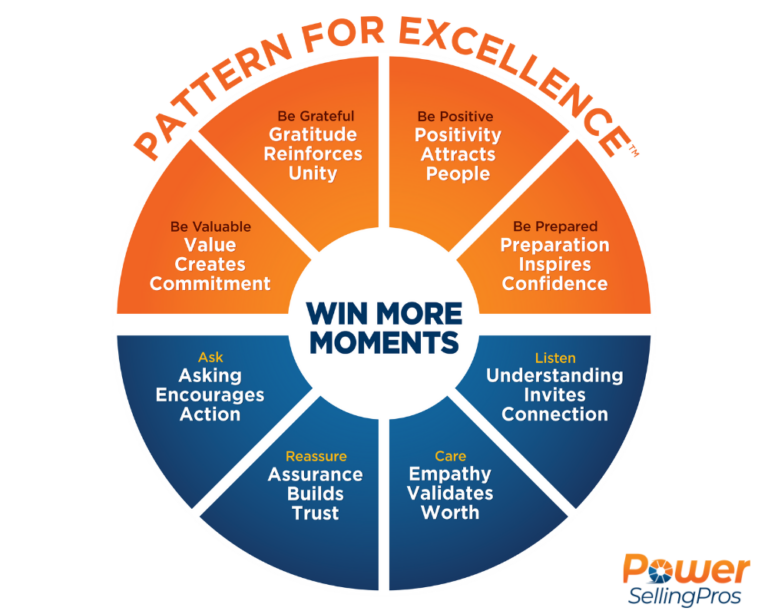Leading With The Pattern For Excellence

Changing The Perspective On Your Role
Owner Operator To Owner Leader
Businesses cannot grow unless owners are able to free themselves from the business so they can work on it instead of in it.
What exactly does it mean to free yourself from the business? This is your creation. You are proud and protective of your projects, as you should be. Yet if you are playing the role of CSR, office manager, supply manager, accountant, sales rep, on-field tech, marketing person…who is left to grow your organization? This is the role you are meant to fill. No one will have the same drive or vision as you to take your business to the next level. This is your priority, your bread and butter.
I’m here to tell you that it’s time to trust. You have what you need to leverage growth in your company – right now. Recognize the talents of the individuals you’ve carefully selected to be a part of your team. You’re in this together. Challenging your team will keep them engaged. Appreciating your team will give them validation. These will be the first steps to shift you from Operator to Leader.

Leadership is more than just a title; it’s an art that requires constant refinement and dedication. As a leader in the home service industry, you play a pivotal role in shaping the culture of your organization, motivating your team, and guiding them toward success. Inspired by the key principles presented in Brigham Dickinson’s upcoming book, Something to Give, this article will be divided into 4 parts to teach you the best practices that extraordinary leaders adopt – not just to create a dynamic, thriving work environment, but to be a leader worth following. In part 1, we will start at the beginning: The Pattern for Excellence.
The Pattern For Excellence
Introducing Our Core Principles
Brigham has always been an entrepreneurial individual – working for himself, thinking outside the box, and encouraging others to do the same. However, this road is not always easy. Over thirteen years ago, Brigham says he hit rock bottom when his business failed. Sitting alone in his sister’s basement, in a desperate moment of despair, he discovered the power of eight timeless principles that he wholeheartedly believed lead to success in life:

Be Positive –Positivity Attracts People
Be Prepared– Preparation Inspires Confidence
Listen – Understanding Invites Connection
Care – Empathy Validates Worth
Say “YES” – Reassurance Builds Trust
Ask – Asking Encourages Action
Build Value – Value Creates Commitment
Be Grateful – Gratitude Reinforces Unity
These principles became Brigham’s lifeline. He decided to embark on a new venture. It wasn’t smooth sailing, and soon one of his early clients was on the verge of letting him go. But he wouldn’t accept defeat – not again. Drawing on Brigham’s past experience as a CSR, he offered to coach his client’s team for a month, for free, believing that they could turn things around. Miraculously, it worked! They began booking more calls, selling more memberships, and creating a culture shift driven by those same timeless principles.
What started as a desperate attempt to retain a client transformed into something much greater. Brigham stepped away from doing “too much” by trusting his team to do exceptional work. By doing this, he gave himself space to grow as a leader. He stuck with his work ethic and let the principles pave the way. Today, as the founder of Power Selling Pros, together with his team, we coach over 1000 CSRs across the United States, Canada, and Australia. Brigham says, “I know I can’t do what I do by myself; a leader is nothing without their followers.” The momentum of this journey thrust him into a role of leadership.
Let The Pattern Lead The Way
A Deeper Look at the First 5 Principles
When we let the pattern lead, it becomes internalized; leading to more than just how to take a call, it becomes a lifestyle. Each principle is integrated in such a way that the flow of communication and interaction will become natural. It is a guideline for creating your culture and setting up the foundation of your work ethic, as well as influencing your employees to follow your lead.
The first 5 principles are the cornerstone to “win the moment.” This is our way of saying we can win over the experience in that moment as it is happening, to set ourselves up for continued success.

Be Positive – We know that emotions can be contagious. People like to be around positive people. It’s as simple as that. Clients, employees, friends, family – you name it. Being positive sets the tone. If you bring the energy and believe in the capabilities of those surrounding you, you will attract positivity in return. That’s not to say “bad days” will never happen, because that’s simply not true. Being human means we feel all the feelings. As stated in Brigham’s book, “It’s how quickly you recover that’s the measure of a leader—how you handle and work your way out of those negative situations.” – Something to Give
Be Prepared – Being prepared will not reveal the unknown circumstances of what the future holds. What it will do, however, is provide you with the necessary tools and opportunities to find a way through unexpected challenges when they arise. A prepared team is confident in their ability to use creative problem solving skills. A prepared leader is able to step back to look at the big picture to maintain organization, create protocols, and continue to perform no matter the situation.

Care: While it may sound obvious that you should care for others doesn’t mean it is something always put into practice. Did you know there’s a difference between sympathy and empathy? Sympathy: I feel sorry for you. Empathy: I feel you. Genuine caring is the ability to care about your teammates in work and non-work related matters. You are taking an interest in their victories and challenges by responding with empathy. When mistakes happen, you are teaching your team to learn rather than react with anger. When you care, you validate another person’s emotions.
Reassure: Reassurance is a trust building principle that shows every member of your team where they belong and why they are important. When you create a vision for your company, you must believe in that vision yourself before others will follow you. From there, each individual should know their role within the vision. When someone feels how they fit in, they achieve fulfillment and recognition. Reassure your team of their duties and encourage them with positive words of assurance.

A Leader Worth Following
To become a leader worth following you must first start by shifting your perspective and begin to formulate new habits. We want to use this Pattern for Excellence (PFE) as a launching point to guide you through an outline of personal innovations and best practices. By mastering these key principles today, you can lead your team to achieve extraordinary heights.
A deeper and thorough understanding of these principles (and much more) can be read in Brigham’s upcoming book, Something to Give, available now for pre-order.
